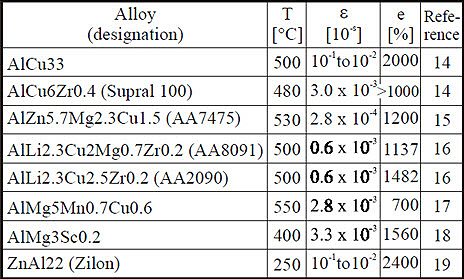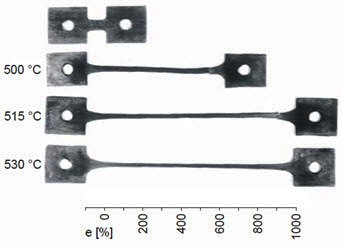Superplasticity of Aluminum Alloys: Part One
Abstract
It is known that superplasticity refers to the ability of a material to demonstrate under tensile tests very high uniform deformation more than several hundreds percents without visible necking. There are two basic requirements in order to achieve superplastic flow in a polycrystalline material. First, the material must have a very small and stable grain size less than 10 μm. Second, superplasticity is achieved only at relatively high temperatures above 0.5Tm (where Tm is the absolute melting temperature) because superplasticity is diffusion-controlled process.
It is known that superplasticity refers to the ability of a material to demonstrate under tensile tests very high uniform deformation more than several hundreds percents without visible necking. There are two basic requirements in order to achieve superplastic flow in a polycrystalline material. First, the material must have a very small and stable grain size less than 10 μm. Second, superplasticity is achieved only at relatively high temperatures above 0.5Tm (where Tm is the absolute melting temperature) because superplasticity is diffusion-controlled process.
The first aluminium alloys with super plastic properties had eutectoidal or eutectic composition, e. g. AlCu33 alloy. They were not applied in practice due to unsuitable mechanical properties, though they possessed good plasticity. In 1970s, super plastic alloys with compositions and mechanical properties similar to those of ordinary aluminium alloys, were discovered. Since then, the development of those materials has an upward trend. Some superplastic alloys are already industrially produced and used in practice. Among the most known and useful alloys are the AA2004 (Al-Cu-Zr), AA7475 (AlZnMgCu), AA5083 (AlMgMn), and AlLiX (Table 1.).

Table 1: Working conditions (working temperature T, strain rate), and the highest elongations e, for some aluminium alloys, in comparison with the ZnAl22 alloy

Figure 1: Plasticity of the AlZnMgCu alloy at various working temperatures and strain rate 7.5x10-4 s-1
Superplastic sheet metals enable the fabrication of complex-shaped products with a single working operation using relatively inexpensive tools.
Application of superplastic materials highly reduces the manufacturing costs due to reduced consumption of energy and materials, by reducing unnecessary joining of single sections, and by using one single tool which can be made of undemanding, cheap material. Savings in tools represent up to 90 % in comparison with manufacturing equally complex products of ordinary materials. Application of superplastic materials is suitable for making complex items in small and medium series of 50 to 10 000 pieces. Bigger series are at present not yet economic due to too long shaping times. Aluminium superplastic alloys are used for manufacturing aircraft components, components of car bodies, for housing, components of various apparatuses and musical instruments, and components in building, like linings of buildings, and for decoration purposes.
High-strength AlZnMgCu, AlCuZr, and AlLiX alloys are mainly used in aircraft industry; AlMgMn alloys are more generally used for road and rail vehicles, and in civil engineering. Further development of superplastic materials will be directed towards cheaper manufacturing of those materials and to rationalisation of superplastic working. Further efforts to improve the plasticity are not needed. The plasticity, possessed by such present aluminium materials, already corresponds to the demands of superplastic working.
Seguir leyendo
¡Acceda Ahora a las Propiedades Precisas de las Aleaciones de Aluminio!
Total Materia Horizon contiene información sobre las propiedades de más de 30.000 aluminios: composición, propiedades mecánicas, físicas y eléctricas, propiedades no lineales y mucho más.

Obtenga una cuenta de prueba GRATUITA de Total Materia Horizon y únase a nuestra comunidad que traspasa los 500.000 usuarios provenientes de más de 120 países.